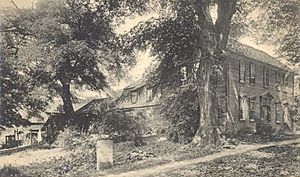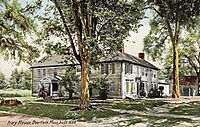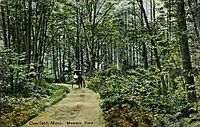Deerfield, Massachusetts facts for kids
Quick facts for kids
Deerfield, Massachusetts
Pocumtuck
|
|||
|---|---|---|---|
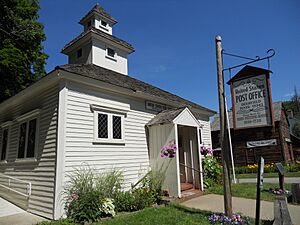
Post office in Deerfield
|
|||
|
|||
| Motto(s):
"New England as you hope to find it"
|
|||
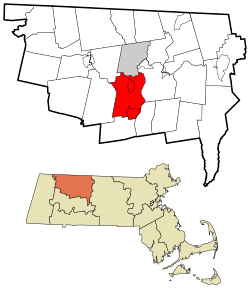
Location in Franklin County in Massachusetts
|
|||
| Country | United States | ||
| State | Massachusetts | ||
| County | Franklin | ||
| Settled | 1673 | ||
| Incorporated | October 22, 1677 | ||
| Government | |||
| • Type | Open town meeting | ||
| Area | |||
| • Total | 33.4 sq mi (86.6 km2) | ||
| • Land | 32.4 sq mi (83.9 km2) | ||
| • Water | 1.1 sq mi (2.8 km2) | ||
| Elevation | 151 ft (46 m) | ||
| Population
(2020)
|
|||
| • Total | 5,090 | ||
| • Density | 152.23/sq mi (58.78/km2) | ||
| Time zone | UTC−5 (Eastern) | ||
| • Summer (DST) | UTC−4 (Eastern) | ||
| ZIP Code |
01342
|
||
| Area code(s) | 413 | ||
| FIPS code | 25-16670 | ||
| GNIS feature ID | 0618162 | ||
Deerfield is a town in Franklin County, Massachusetts, United States. It was settled in the 1600s near the Connecticut River. In 2020, about 5,090 people lived there. Deerfield is part of the larger Springfield area in western Massachusetts. It is about 30 miles (48 km) north of Springfield city.
Deerfield has two main villages: South Deerfield and Old Deerfield. Old Deerfield is home to two cool museums. The Historic Deerfield museum is a special place known as a National Historic Landmark. It shows what life was like from colonial times up to the late 1800s. You can explore eleven old house museums there! The Pocumtuck Valley Memorial Association runs the Memorial Hall Museum, which opened in 1880. They also have the Indian House Memorial Children's Museum.
This town has a rich history, including some early conflicts. Today, many people visit Deerfield to learn about its past. It's a popular spot for "heritage tourism" in the Pioneer Valley.
Deerfield also has many schools. These include Deerfield Academy, a private high school, and Frontier Regional High School. There's also Deerfield Elementary for younger students. Plus, there are two private boarding schools for younger kids: Bement School (for both boys and girls) and Eaglebrook School (for boys).
Contents
History of Deerfield
Early Times and Native Americans
For many years, Deerfield was the furthest point where English settlers lived in New England. It's in a rich farming area called the Pioneer Valley. Because of its location near the the Berkshires mountains, it was often a place of conflict. Different Native American groups and later, French and English settlers, fought over the land.
When English colonists first arrived, the Pocumtuck people lived in the Deerfield area. They spoke an Algonquian language and had a large village there.
How Deerfield Was Settled
The town of Dedham, Massachusetts, was given 8,000 acres (32 km2) of land as a gift. They sent people to explore the area in 1663. They found a good spot called Pocumtuck, which was about 12 to 14 miles from Hadley. They decided to claim this land quickly.
A man named Joshua Fisher mapped the land. The General Court, which was like the government back then, agreed to give the land to Dedham. But they had to settle the land and start a church within five years.
Two other men, Daniel Fisher and Eleazer Lusher, were sent to buy the land from the Pocumtuck Native Americans. They worked with John Pynchon, who knew the native people. Pynchon got a deed from them. However, Native Americans and English settlers had different ideas about land ownership. This difference, along with competition for resources, led to problems between them.
Settlers started moving to the area around 1670. On May 7, 1673, the General Court officially made Deerfield its own town. They added more land and asked the settlers to build a church and find a minister within three years.
Life After Deerfield Was Formed
By the time settlers arrived, the Pocumtuck people had fewer members. They had suffered from diseases and wars with the powerful Mohawk tribe. The settlers forced the remaining Pocumtuck people to leave. Many Pocumtuck then sought protection from the French in Canada.
There were some important battles in Deerfield's early history. At the Battle of Bloody Brook in 1675, during King Philip's War, Native Americans attacked a small group of settlers. About 60 colonists died. In 1676, Captain William Turner led a surprise attack on a Native American gathering place. His forces killed many Native Americans, mostly women and children. When the men of the tribe returned, they defeated Turner's forces, and Turner was killed.
On February 29, 1704, during Queen Anne's War, French and Native American forces attacked Deerfield. This event is known as the Raid on Deerfield. They destroyed much of the town and killed 56 colonists. They also took 112 people captive, including women and children. These captives were forced to walk nearly 300 miles (480 km) to Montreal. Many died on the journey.
During this time, people would often pay money to get captives back. Deerfield and other towns raised money to free their people. The Massachusetts Bay Colony even released a French pirate to help get Deerfield captives back. One famous captive was the minister John Williams, who later wrote a book about his experience.
Some captives, especially younger ones, were adopted into Native American tribes. For example, Williams's daughter, Eunice, was 8 when she was captured. She grew up with the Mohawk people and married a Mohawk man. She stayed with them for the rest of her life. Most of the Deerfield captives eventually returned to New England, but some chose to stay with the French and Native communities.
As time went on, Deerfield became a more peaceful town. In 1753, Greenfield became its own town. In the early 1800s, farming in Deerfield became less important. This was because new areas in the Midwestern United States became major farming regions. Also, new ways to transport goods, like the Erie Canal and railroads, made it easier to get food to cities.
In the late 1800s, people in Deerfield became very interested in their town's history. They started groups like the Pocumtuck Valley Memorial Association in 1870. They also built monuments to remember important events, like the Bloody Brook and 1704 attacks. Charlotte Alice Baker helped restore her family home, the Frary House, in 1890. This was one of the first projects to save old buildings in western Massachusetts.
A local historian named George Sheldon wrote about the town's early history. Around this time, new immigrants from Eastern Europe, especially Poland, started moving to South Deerfield. Most were Catholic farmers who built their own churches. They formed a community known as Old Polonia. Later Polish immigrants were often more educated and moved to bigger cities.
Today, visiting historical sites is Deerfield's main industry. Historic Deerfield is a National Historic Landmark district. It has eleven house museums and a visitors' center. It focuses on old American art, culture, and history. The Pocumtuck Valley Memorial Association runs the Memorial Hall Museum, which opened in 1880. They also have the Indian House Memorial Children's Museum. Deerfield is a key place for "heritage tourism" in the Pioneer Valley near the Connecticut River. The Yankee Candle Company is another well-known business connected to the area's history.
Geography and Nature
Deerfield covers about 86.6 square kilometers (33.4 sq mi) in total. Most of this is land (83.9 km2 or 32.4 sq mi), and a small part is water (2.8 km2 or 1.1 sq mi). The town is in the northern part of the Pioneer Valley. It shares borders with several other towns like Greenfield to the north and Whately to the south.
The Deerfield River flows through the northwestern part of town, and the Connecticut River forms the eastern border. Many smaller streams also run through Deerfield. North Sugarloaf Mountain is a tall peak in the southeastern part of town. From its top, you can see amazing views of the valley and the town center. The Pocumtuck Range of hills is also along the eastern side of town.
Travel and Transportation
Interstate 91 runs through the middle of Deerfield from south to north. It crosses the Deerfield River. U.S. Route 5 and Massachusetts Route 10 also go through the town. Route 116 also passes through, briefly joining Routes 5 and 10. These routes used to go through the very center of the village but were moved when I-91 was built.
A freight train line, the Springfield Terminal, goes through Deerfield. For passenger trains, the closest Amtrak station is in Springfield. There's also a stop in Greenfield for the Vermonter train route. Deerfield has bus service through Peter Pan Bus Lines. For air travel, smaller airports are in Gill and Northampton. The closest major airport is Bradley International Airport in Windsor Locks, Connecticut.
People of Deerfield
| Historical population | ||
|---|---|---|
| Year | Pop. | ±% |
| 1840 | 1,934 | — |
| 1850 | 2,421 | +25.2% |
| 1860 | 3,073 | +26.9% |
| 1870 | 3,632 | +18.2% |
| 1880 | 3,543 | −2.5% |
| 1890 | 2,910 | −17.9% |
| 1900 | 1,969 | −32.3% |
| 1910 | 2,209 | +12.2% |
| 1920 | 2,803 | +26.9% |
| 1930 | 2,882 | +2.8% |
| 1940 | 2,684 | −6.9% |
| 1950 | 3,086 | +15.0% |
| 1960 | 3,338 | +8.2% |
| 1970 | 3,850 | +15.3% |
| 1980 | 4,517 | +17.3% |
| 1990 | 5,018 | +11.1% |
| 2000 | 4,750 | −5.3% |
| 2010 | 5,125 | +7.9% |
| 2020 | 5,090 | −0.7% |
| 2023 | 5,176 | +1.7% |
Source: United States Census records and Population Estimates Program data. |
||
In 2010, there were 5,125 people living in Deerfield. There were 2,053 households, and 1,350 families. About 95% of the people were White. Other groups included African American, Native American, and Asian people. About 2.6% of the population was Hispanic or Latino.
The average household had 2.33 people, and the average family had 2.83 people. In 2015, the average income for a household was $74,853. About 7.5% of the population lived below the poverty line.
Schools in Deerfield
Deerfield is part of the Frontier Regional and Union 38 School Districts. These districts also include the towns of Conway, Whately, and Sunderland. Each town has its own elementary school. Deerfield Elementary School teaches students from kindergarten through sixth grade.
All students from these four towns go to Frontier Regional School in Deerfield for seventh through twelfth grades. Frontier's sports teams are called the Red Hawks, and their colors are red and blue. The school also has many art programs.
Deerfield has several private schools:
- The Bement School: A boarding school for boys and girls from kindergarten to ninth grade.
- The Eaglebrook School: A private boarding school for boys from sixth to ninth grade.
- Deerfield Academy: A private high school for grades 9-12.
For higher education, the closest community college is Greenfield Community College in Greenfield. Nearby state colleges include Massachusetts College of Liberal Arts and Westfield State University. The University of Massachusetts Amherst is also close by. Other private colleges nearby are Amherst College, Hampshire College, Mount Holywood College, and Smith College.
Famous People from Deerfield
- Frank Boyden (1879–1972): A long-time Headmaster of Deerfield Academy.
- Alon Bement (1876–1954): An artist and educator whose family helped start Deerfield.
- Francis John Higginson (1843–1931): A rear admiral in the U.S. Navy who grew up in Deerfield.
- Irwin Rose (1926–2015): A biologist and Nobel Prize winner who died in Deerfield.
- George Sheldon (1818–1916): A Deerfield town historian and a leader in saving historical places.
- Jennie Maria Arms Sheldon (1852–1938): A curator at Deerfield's Memorial Hall Museum.
- Lucy Terry (c. 1730–1821): An African-American poet who was enslaved in Deerfield.
- John Williams (1817–1899): An Episcopal bishop born in Deerfield.
See also
 In Spanish: Deerfield (Massachusetts) para niños
In Spanish: Deerfield (Massachusetts) para niños




